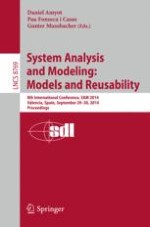2014 | Book
System Analysis and Modeling: Models and Reusability
8th International Conference, SAM 2014, Valencia, Spain, September 29-30, 2014. Proceedings
Editors: Daniel Amyot, Pau Fonseca i Casas, Gunter Mussbacher
Publisher: Springer International Publishing
Book Series : Lecture Notes in Computer Science
